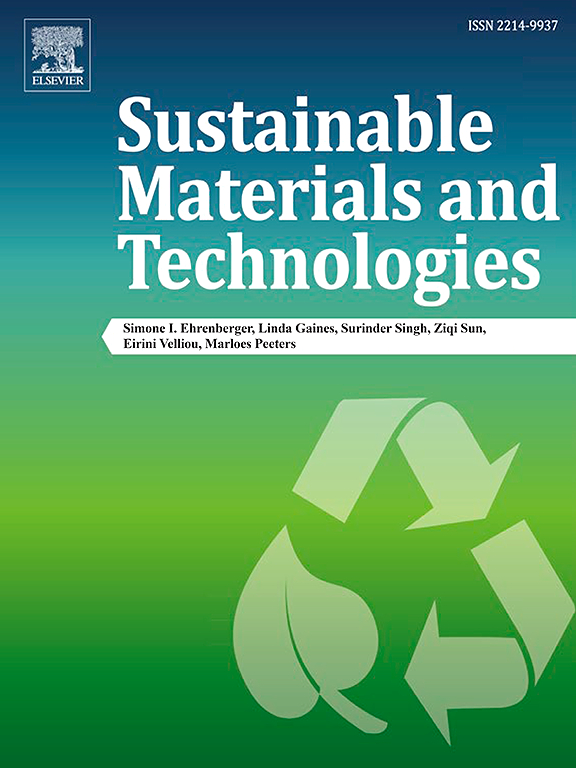Exploring a non-aqueous hybrid zinc/potassium battery with monovalent ion (de)-insertion at high voltage in potassium/sodium manganese(II) hexacyanoferrates(II)
IF 8.6
2区 工程技术
Q1 ENERGY & FUELS
引用次数: 0
Abstract
Non-aqueous zinc batteries as a complement to lithium ion batteries continue attracting the attention for energy storage in stationary systems because of the high volumetric energy density and competitive production costs. Unfortunately, the rapid development of such technology is hindered by technical issues such as sluggish diffusion of Zn2+ within the host material. In this work we demonstrate that is possible to use a non-aqueous hybrid Zn/K battery circumventing the Zn2+ insertion effects into two host structures by using monovalent ions. For this approach two different structures with different alkali earth metals (K and Na) are tested as the cubic (N-MF: Na1.9Mn[Fe(CN)6]0.95·3.9H2O) and monoclinic (K-MF: K1.9Mn[Fe(CN)6]0.94·0.61H2O) PBAs. Intriguing phase changes and voltage of the reactions are disclosed. A single voltage plateau occurred at 2 V in charge and 1 V on discharge for K-MF. Voltage plateaux between 2.05 and 2.65 and 3.05 V on charge, and 1.2–0.95 V on discharge for N-MF are observed. Two active redox centres Fe2+/3+ and Mn2+/3+ trigger a multi-electron reaction with 141.2 (K-MF) and 117.7 mA h g−1 (N-MF). Eventually, a wide electrochemical voltage can be used for N-MF cathode to 3.25 V (vs. Zn2+/Zn) with a characteristic phase transformation from cubic to monoclinic on cycling, reporting data to enhance the voltage and energy density. Therefore, the results reported here try to promote fundamental progress within the field of non-aqueous Zn/K batteries.

高压下六氰高铁钾/锰钠(II)中单价离子插入的非水杂化锌/钾电池的研究
非水锌电池作为锂离子电池的补充,因其体积能量密度高和具有竞争力的生产成本,在固定系统的能量存储方面一直备受关注。遗憾的是,这种技术的快速发展受到技术问题的阻碍,例如 Zn2+ 在主材料中的缓慢扩散。在这项工作中,我们证明了可以使用非水性 Zn/K 混合电池,通过使用单价离子来规避 Zn2+ 在两种宿主结构中的插入效应。为此,我们测试了含有不同碱土金属(K 和 Na)的两种不同结构的立方(N-MF:Na1.9Mn[Fe(CN)6]0.95-3.9H2O)和单斜(K-MF:K1.9Mn[Fe(CN)6]0.94-0.61H2O)PBA。研究揭示了反应中有趣的相变和电压。K-MF 在充电时的电压为 2 V,放电时的电压为 1 V。对于 N-MF,观察到充电电压在 2.05 至 2.65 V 和 3.05 V 之间,放电电压在 1.2 至 0.95 V 之间。两个活性氧化还原中心 Fe2+/3+ 和 Mn2+/3+ 触发了多电子反应,电流分别为 141.2 mA h g-1(K-MF)和 117.7 mA h g-1(N-MF)。最终,N-MF 阴极的电化学电压可达到 3.25 V(相对于 Zn2+/Zn),并在循环过程中发生从立方到单斜的特征性相变,报告了提高电压和能量密度的数据。因此,本文报告的结果试图推动非水 Zn/K 电池领域的根本性进展。
本文章由计算机程序翻译,如有差异,请以英文原文为准。
求助全文
约1分钟内获得全文
求助全文
来源期刊

Sustainable Materials and Technologies
Energy-Renewable Energy, Sustainability and the Environment
CiteScore
13.40
自引率
4.20%
发文量
158
审稿时长
45 days
期刊介绍:
Sustainable Materials and Technologies (SM&T), an international, cross-disciplinary, fully open access journal published by Elsevier, focuses on original full-length research articles and reviews. It covers applied or fundamental science of nano-, micro-, meso-, and macro-scale aspects of materials and technologies for sustainable development. SM&T gives special attention to contributions that bridge the knowledge gap between materials and system designs.
 求助内容:
求助内容: 应助结果提醒方式:
应助结果提醒方式:


